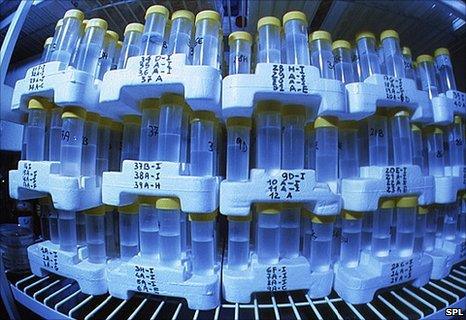Transforming medicine in the genome age
- Published

Within a few years, a standard aspect of your health care could include the decoding of every aspect of your genetic make-up.
This would predict the diseases you are likely to develop in the future, which treatments will work best for your illnesses and what doses would best suit you.
The basic technology for doing this - sequencing the human genome - is evolving at an extraordinary pace. What has been, up until now, a revolutionary research tool is fast advancing towards the clinic.
It took 2,000 of the world's scientists more than 10 years and $2.7bn to read the first human genome. Today the same job takes one lab three weeks and less than $10,000.
Before long, your doctor might soon be able to read your entire genetic code for $1,000 in even less time.
Ten years ago this week - on 26 June 2000 - President Bill Clinton invited scientists into the White House to announce that they had compiled their first draft of the human genome sequence.
The Human Genome Project analysed the entire DNA of what amounted to one individual person. It read out the order, or sequence, of most of the three billion letters of molecular code which it contains.
The genome is the term for this complete set of genetic instructions. It includes the code for some 20,000 genes. It is sometimes described as the "book of life".
John Sulston was the director of the Wellcome Trust Sanger Institute near Cambridge, which sequenced one third of the human instruction manual during the Human Genome Project.
Genome race
As well as regarding the feat as an historic scientific achievement, he believes that the sequencing of our genome was a significant philosophical milestone.
"Here we have a species, ourselves, which in the course of four and half billion years of evolution, has arisen and has become smart enough to read out its own code of instructions," he said.
During the later years of the publically-funded project, Professor Sulston and his colleagues found themselves in competition to sequence the genome with a commercial company, Celera Genomics, which was established by Craig Venter.
Dr Venter was in the news only last month, having created a bacterium with an entirely laboratory-made genome.
In conversation with the evolutionary biologist Richard Dawkins on BBC Radio 4's "The Age of the Genome", Craig Venter is in no doubt about the place in history that sequencing the book of life deserves: "I think it's far more important than walking on the Moon; not much has happened since walking on the Moon."
Craig Venter points out that access to the complete genetic code transformed medical research.
"I actually call it a silent revolution because most people don't realise that before we sequenced the human genome, discovering human genes was an extremely slow process."
Before the genome was laid bare, the search for just one gene implicated in a particular illness could take a team of scientists longer than ten years. Today gene hunting is much easier and quicker.
In 2000, we knew of just a handful of genes which influence our risk of developing common diseases such as diabetes, heart disease and cancers.
According to Peter Donnelly, director of the Wellcome Trust Centre for Human Genetics, says: "Because of the experiments we are now able to do, that number has gone from ten or twenty to something like 700, across well over 100 diseases now."
However, there are still many more genes to discover and characterise before doctors are in a position to offer us a broad and accurate "one-shot" genome reading.
One of the clinical expectations from the human genome project was that one day we would be going to our doctors for a personal genome reading.
These DNA check-ups would reveal with precision our individual risks for the whole gamut of common diseases. Our doctors would advise us on lifestyle and prescribe preventive medicines and measures accordingly, tailored to our genetic endowment.
Faster, cheaper
The technical means to do this cheaply is likely to be in place if and when geneticists have identified enough genetic information to make clinical genomic scans worthwhile.
The speed at which a genome can be sequenced doubles every year. The price is also plummeting. The cost of decoding a human has fallen by 320,000 times.
At the Wellcome Trust Centre for Human Genetics, Mark McCarthy is currently sequencing the genomes of 3,000 individuals in the search for genetic differences which predispose some people to type 2 diabetes.
He says that although DNA sequencing machines are currently only affordable and useful for research, it might not be many years before they are at work in the health service.
"There are certainly efforts to drive the costs down to a few hundred dollars in the not too distant future," he says.
"And when you think about it that compares to the cost of an MRI scan or an endoscopy or many of the things we consider to be regular parts of clinical practice.
"And then the questions will be whether the information that we can gather from knowing your genome or my genome could be useful in terms of offering you or me better clinical care."
Part one of The Age of the Genome presented by Professor Richard Dawkins is broadcast on Wednesday, 23 June, 2010 at 2100 BST on BBC Radio 4. Or catch-up afterwards on Listen again
- Published21 June 2010
- Published20 May 2010
- Published8 February 2010
- Published9 April 2009
- Published2 March 2009
- Published9 January 2009